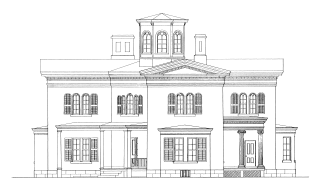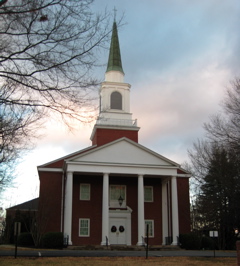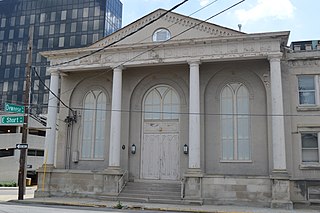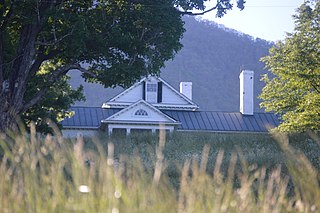
Yadkin County is a county located in the U.S. state of North Carolina. As of the 2020 census, the population was 37,214. Its county seat is Yadkinville. Yadkin County is included in the Winston-Salem, NC Metropolitan Statistical Area, which is also included in the Greensboro–Winston-Salem–High Point, NC Combined Statistical Area.

Jonesville, originally called Allen's Settlement, is the oldest town in Yadkin County, North Carolina, United States. The population was 2,285 at the 2010 census. The town grew by nearly 800 residents in 2001 when it merged with neighboring Arlington. Recognized as the Heart of the Yadkin Valley, Jonesville is a gateway to the Blue Ridge Mountains, the Yadkin Valley Heritage/Cultural Corridor and to local wineries in the Swan Creek AVA and the larger Yadkin Valley AVA, as well as offering access to the Yadkin river.
Richard Clauselle Puryear was a U.S. Congressman from North Carolina between the years of 1853 and 1857. A planter and politician, he also served in the North Carolina House for several terms and the state senate.

Cooleemee, also known as the Cooleemee Plantation House, is a house located between Mocksville and Lexington, North Carolina, at the terminus of SR 1812 on the Yadkin River in Davie County, North Carolina. It is a U.S. National Historic Landmark, designated in 1978 for its architecture.

Pinnacle is an unincorporated community and census-designated place in southwestern Stokes County, North Carolina, United States, approximately 5 miles (8.0 km) SSE of the town of Pilot Mountain, between Pilot Mountain State Park and Hanging Rock State Park.

Waveland State Historic Site, also known as the Joseph Bryan House, in Lexington, Kentucky is the site of a Greek Revival home and 10 acres now maintained and operated as part of the Kentucky state park system. It was the home of the Joseph Bryan family, their descendants and the people they enslaved in the nineteenth century. Bryan's father William had befriended Daniel Boone and they migrated west through the Cumberland Gap.

Stagville Plantation is located in Durham County, North Carolina. With buildings constructed from the late 18th century to the mid-19th century, Stagville was part of one of the largest plantation complexes in the American South. The entire complex was owned by the Bennehan, Mantack and Cameron families; it comprised roughly 30,000 acres (120 km2) and was home to almost 900 enslaved African Americans in 1860.

Richmond Mumford Pearson was an American jurist who served as chief justice of the North Carolina Supreme Court from 1859 to 1878. He was the father of Congressman Richmond Pearson and the father-in-law of North Carolina Governor Daniel Gould Fowle.
Alfred "Teen" Blackburn was one of the last surviving American slaves with a clear recollection of slavery as an adult. He was known throughout Yadkin County, North Carolina for his strength, size, and longevity. While enslaved, he served as a body servant for his owner, a Confederate soldier, during the Civil War. In 1929, state officials granted him a Class B pension in North Carolina, leading some to mistakenly describe him as a Confederate veteran.
Huntsville is a small unincorporated community in Yadkin County, North Carolina, United States. The community was formerly chartered in 1792 by Charles Hunt of Salisbury, NC and was chartered again in 1822. It has a Huntsville Volunteer Fire Department, and Huntsville Community Center which is in front of a baseball/softball field which is home to Huntsville little league.

Enon is an unincorporated community in eastern Yadkin County, North Carolina, United States. The community, which is centered on Enon Baptist Church, is in the Forbush Township and in the East Bend ZIP code zone (27018). It is a Piedmont Triad community.

John Hill Wheeler (1806–1882) was an American attorney, politician, historian, planter and slaveowner. He served as North Carolina State Treasurer (1843–1845), and as United States Minister to Nicaragua (1855–1856).

The High Hills of Santee, sometimes known as the High Hills of the Santee, is a long, narrow hilly region in the western part of Sumter County, South Carolina. It has been called "one of the state's most famous areas". The High Hills of Santee region lies north of the Santee River and east of the Wateree River, one of the two rivers that join to form the Santee. It extends north almost to the Kershaw county line and northeasterly to include the former summer resort town of Bradford Springs. Since 1902 the town has been included in Lee County.

First African Baptist Church is a Baptist church at 264-272 E. Short Street in Lexington, Kentucky. The congregation was founded c. 1790 by Peter Durrett and his wife, slaves who came to Kentucky with their master, Rev. Joseph Craig, in 1781 with "The Travelling Church" of Baptists from Spotsylvania, Virginia.

Pharsalia is a historic plantation house and farm complex located near Tyro, Nelson County, Virginia. The main house was built between 1814 and 1816 using slave labor, and is a one-story, 11 bay, linear, single-pile, Federal style, frame manor house. It has a standing seam metal gable roof and features a three-bay porch with a gable roof. It was enlarged in the mid-19th century to its current T-shaped plan. Also on the property are the contributing kitchen / laundry / slave hospital (1834), icehouse / School, crib barn, smokehouse (1814), weaving Room, several slave quarters, and privy. Also on the property are the sites of a commercial smokehouse and mill.
Rufus Reid (1797–1854) was an American plantation owner, businessman and politician from North Carolina.
John Ker (1789–1850) was an American surgeon, planter, and politician in Louisiana. Together with several major Mississippi planters, in the 1830s Ker co-founded the Mississippi Colonization Society (MCS), promoting the removal of free people of color to a colony in West Africa. The MCS modeled itself after the American Colonization Society, the national organization for which Ker later served as a vice president.

Fort Defiance is a historic plantation house located near Lenoir, Caldwell County, North Carolina. The main block was built between 1788 and 1792, and is a two-story, frame structure measuring 28 feet by 40 feet. A wing was added in 1823. It was the home of Revolutionary War General William Lenoir. The property was transferred to the Caldwell County Historical Society in 1965 and operated as a historic house museum.
Durrett-Jarratt House, also known as the Isaac Jarratt House, is historic plantation house located near Enon, Yadkin County, North Carolina. It was built about 1820, and is a large, two-story, four-bay, Federal style frame dwelling. It rests on a brick foundation, has molded weatherboard siding, a gable roof and exterior brick end chimneys. It has a mid-19th century shed roofed front porch, and dining room and kitchen additions. Also on the property is a contributing commissary building. The interior features original wood graining and decorative painting.

Charles Norfleet Hunter, more commonly known as Charles N. Hunter, was an American educator, journalist, and historian. Hunter actively engaged in several late nineteenth-century reform movements. In the 1870s, he participated in the Temperance movement. Beginning in his twenties, Hunter played a significant role as a teacher or principal at the "Colored Graded Schools" in Durham, Goldsboro, and Raleigh as well as at rural schools in Robeson, Chatham, Cumberland, and Johnston Counties. Hunter also helped lead an initiative to build the Berry O'Kelly Training School in Method, North Carolina.


















